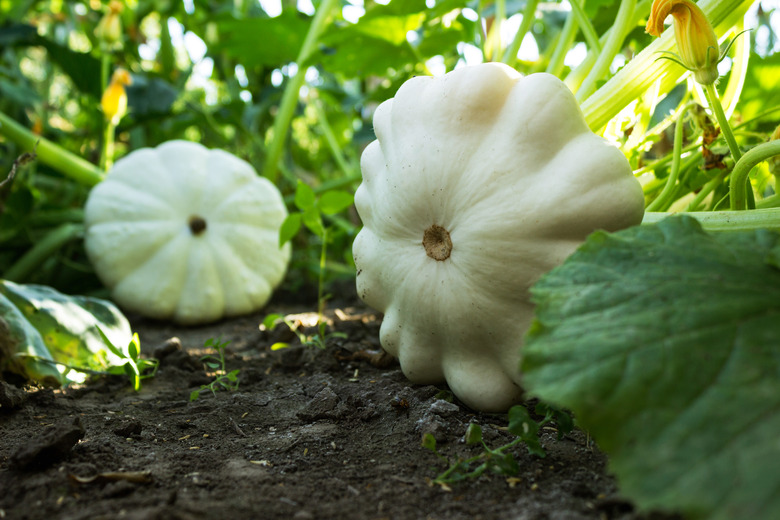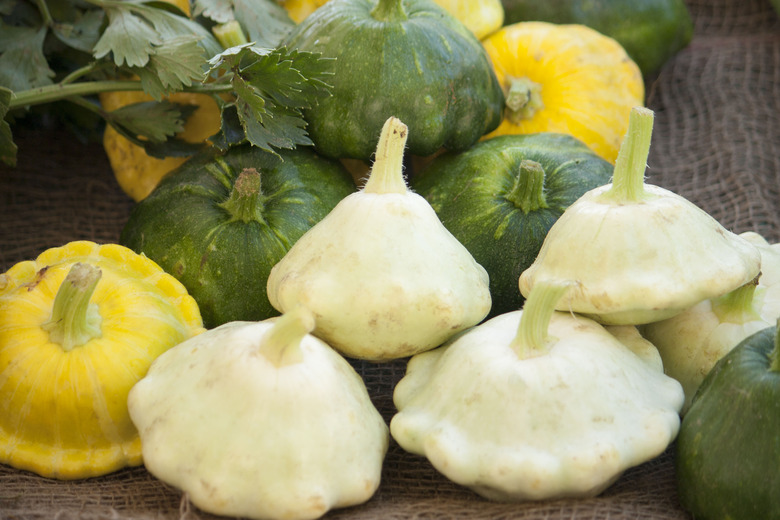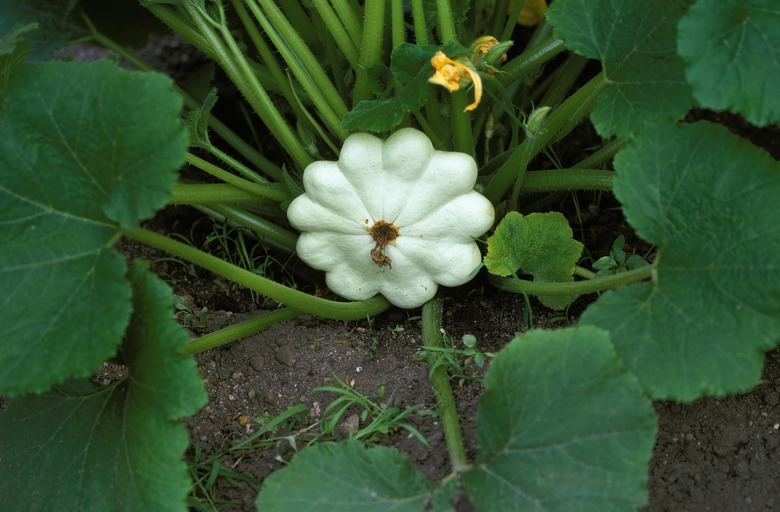How To Grow Pattypan Squash
We may receive a commission on purchases made from links.
Even if your kids refuse to eat their vegetables, you might be able to coax them into eating flying saucers from outer space. Sometimes called scallopini squash, pattypan squash (Cucurbita pepo var. ovifera) is a petite summer vegetable that truly does look like a flying saucer. With a flavor similar to that of zucchini but with a dryer consistency, pattypan is popular among home gardeners, and it is quite easy to grow.
Like all squashes, however, pattypan plants tend to sprawl out. If you are working in a small space, consider trellising the vines so your plants can grow up rather than out.
Best Uses for Pattypan Squash
Best Uses for Pattypan Squash
Historically, the Iroquois grew summer squashes like pattypans as one of their big three food crops. The Native Americans grew corn and then planted vining bean or squash plants around the corn. As the squash vine grew along the corn, it strengthened it and prevented strong winds from blowing over the corn crop. In return, the corn gave the vines a solid structure to climb.
Today, the only excitement pattypan squash adds to your vegetable garden is the joy of eating it. It is not a particularly attractive plant, and its sprawling nature makes it far too unwieldy to plant along borders or in flower beds. Instead, pick a planting location where your squash will have lots of room to stretch its legs.
At harvest time, you can cook your pattypan squash in a number of ways, all of them delicious. You can grill it, steam it, slice it or dice it, eating it alone or as part of another dish. You can also channel your inner Martha Stewart by carving out the middle of the squash and using the shell as an edible serving dish.
However you cook it, pattypan is a nutritious addition to your diet. In just 18 calories, pattypan squash provides more Vitamin A, niacin, and folate than zucchini. The high levels of folate make pattypan a good choice for women in the early stages of pregnancy. Pattypan is also a good source of calcium, vitamin C, and manganese.
Starting Pattypan Squash From Seed
Starting Pattypan Squash From Seed
Most gardeners sow pattypan squash seeds directly in the garden. To do so successfully, wait until the danger of frost has passed in your area.
Before direct-sowing seeds outdoors, work 3 inches of compost into the soil. You can then sow your squash seeds directly in the ground, placing them 1 inch deep and spacing them 18 to 24 inches apart. Many gardeners plant squash on small dirt mounds, placing two to three seeds in each hole. When the seedlings emerge, keep the healthiest-looking one or two seedlings and discard the others. After sowing is finished, gently water your seeds. If all goes well, they will germinate in seven to 14 days.
Starting Pattypan Squash From a Seedling
Starting Pattypan Squash From a Seedling
If you wish to start your pattypan seeds indoors and then transfer the seedlings, plant the seeds in small 2-inch or 3-inch pots, depositing three seeds in each pot. When the seedlings emerge, choose the healthiest one and discard the other two. Move your seedlings outdoors as soon as you can, as squash that is grown in large pots or kept indoors too long will grow large and become unwieldy to plant. When you are starting seeds indoors, do so two to three weeks before the last frost.
Set your seedlings outside for a few hours each day before transplanting them into the garden. Gradually increase the amount of time the seedlings spend outside until they become acclimated to the outdoor environment. When they have become acclimated, plant them in the garden.
Like other squash, pattypan does not take kindly to having its roots disturbed. When transplanting, handle each plant's root ball gingerly and make sure it stays completely intact.
Prepare the soil as you would for seed planting and then plant each squash to the same depth it was planted in its starter pot. Water the plants thoroughly after transplanting.
In What Zone Does Pattypan Squash Grow Best?
In What Zone Does Pattypan Squash Grow Best?
Gardeners grow this annual plant during the warm summer months in USDA plant hardiness zones 2 through 11. Pattypan squash does best in zones 4 through 7, but it will grow in cooler and warmer climates when it is provided with adequate water.
When Should You Plant Pattypan Squash?
When Should You Plant Pattypan Squash?
Pattypan squash likes warm weather, and it will not tolerate even a light frost. Plant it after all risk of frost in your area has passed, and the soil temperature reaches at least 77 degrees Fahrenheit.
This squash variety needs 45 to 55 days of warm summer temperatures to reach maturity and produce well, so plan accordingly. Make sure you plant them after spring's last frost but allow the plants enough time to mature before fall's first frost.
Soil, Sunlight, and Water Recommendations for Pattypan Squash
Soil, Sunlight, and Water Recommendations for Pattypan Squash
Pattypan squash thrives in moist but well-draining slightly acidic soils with a pH level between 6.0 and 6.8. The plants need full sun and at least 1 inch of water per week. It is important to mulch around the seedlings to suppress weeds and to keep the soil moist. As these plants mature, their big leaves will shade the soil and work as a kind of living mulch. As such, you won't need to worry if your mulch starts to thin as the season goes on.
Although it is more compact than many other types of squash, pattypan plants can easily reach diameters of 3 to 4 feet, sending leggy vines throughout your garden. Because they are so large, pattypan squash and other squash varieties are heavy feeders. Fertilize plants based on soil test results, but in the absence of a soil test, apply a water-soluble 5-10-10 fertilizer throughout the growing season.
If your garden is small or if you want to make harvesting easier, you can easily train your pattypan squash onto a trellis. Simply weave young growth through the trellis or gently attach it with a soft cloth or string. This will encourage upward rather than outward expansion.
When you are trellising squash plants, pay extra attention to your watering schedule. Plants on the ground can sink suckers into the soil to pull out more nutrients and water if needed. Trellised plants don't have this luxury, and they will rely on you to give them a bit of extra TLC.
How to Harvest Pattypan Squash
How to Harvest Pattypan Squash
Expect to start harvesting your pattypan squash 45 to 55 days after planting. The fruits are ready when they are 2 to 4 inches wide and can't be dented with your fingernail. Pattypans can get larger, reaching up to about 7 inches in diameter. Pick them before this, however, as pattypans get tougher as they get larger.
To harvest, cut the pattypan off the vine with a sharp knife. Leave 1 or 2 inches of stem on the fruit when cutting, as this makes them last longer. Once you start harvesting, check your plants daily and remove the pattypans as needed. If you keep picking, they will keep producing until the growing season ends in the fall. Store your harvested pattypans in the refrigerator in a loose plastic bag for up to 14 days.
Common Pests and Other Problems for Pattypan Squash
Common Pests and Other Problems for Pattypan Squash
There is no denying that certain insects love squash, and if you grow it, they will come. Common pests include squash bugs, cucumber beetles and squash-vine borers. The best way to prevent damage from these pests is to install floating row covers over young and tender plants. Bear in mind that the row covers need to be removed when the plants are flowering; otherwise, pollinators won't be able to get to the flowers to pollinate them, and fruits cannot form.
If you have tried everything else and you are still seeing large numbers of pests, treat your plants with insecticidal soap or neem oil. Use insecticidal soap sparingly, as it can burn squash leaves.
Common Diseases for Pattypan Squash
Common Diseases for Pattypan Squash
Pattypan squash growers frequently encounter powdery mildew, blossom end rot, and bacterial wilt. Powdery mildew rarely proves to be lethal, but it can kill plant leaves. The lack of shade this creates can cause sunburn on the pattypans.
To avoid powdery mildew, always aim irrigation water at the base of your plants rather than at their leaves. Water early in the morning so that any moisture the leaves do collect has ample time to dry. Keep weeds to a minimum and space plants properly to ensure adequate airflow. Prune away infected leaves to prevent spread.
If your pattypans are rotting rather than growing, you are likely dealing with blossom end rot. This is not a disease but a sign that the plant is not getting enough calcium. To correct the problem, avoid high-nitrogen fertilizers and keep your soil pH between 6.0 and 6.5.
Bacterial wilt causes the leaves of a squash plant to wilt during the day, often seeming to recover at night. It may start with just a few leaves but will eventually spread to the entire plant. The best way to avoid it is to keep cucumber beetles under control, rotate your crops and keep your garden free of debris and weeds. Remove and destroy infected plants because you are not likely to save them once the disease takes hold.


